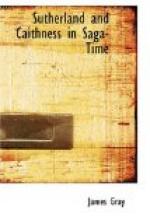As the Romans never occupied Sutherland or Caithness or even came near their borders, their inhabitants were never disarmed or prevented from the practice of war, and thus enfeebled like the more southerly Britons.
After the departure, in 410, of the Romans, St. Ninian sent his missionaries over Pictland, but darkness broods over its history thenceforward for a hundred and fifty years. Picts, Scots of Ireland, Angles and Saxons swarmed southwards, eastwards, and westwards respectively into England, and ruined Romano-British civilisation, which the Britons, unskilled in arms, were powerless to defend, as the lamentations of Gildas abundantly attest.
In 563 Columba, the Irish soldier prince and missionary, whose Life by Adamnan still survives,[9] landed in Argyll from Ulster, introduced another form of Christian worship, also, like the Pictish, “without reference to the Church of Rome,” and from his base in Iona not only preached and sent preachers to the north-western and northern Picts, but in some measure brought among them the higher civilisation then prevailing in Ireland. About the same time Kentigern, or St. Mungo, a Briton of Wales, carried on missionary work in Strathclyde and in Pictland, and even, it is said, sent preachers to Orkney.
In the beginning of the seventh century King Aethelfrith of Northumbria had cut the people of the Britons, who held the whole of west Britain from Devon to the Clyde, into two, the northern portion becoming the Britons of Strathclyde; and the same king defeated Aidan, king of the Scots of Argyll, at Degsastan near Jedburgh, though Aidan survived, and, with the help of Columba, re-established the power of the Scots in Argyll.
About the year 664, the wars in the south with Northumbria resulted in the introduction by its king Oswy into south Pictland of the Catholic instead of the Columban Church, a change which Nechtan, king of the Southern Picts, afterwards confirmed, and which long afterwards led to the abandonment throughout Scotland of the Pictish and Columban systems, and to the adoption in their place of the wider and broader culture, and the politically superior organisation and stricter discipline of the Catholic Church, as new bishoprics were gradually founded throughout Scotland by its successive kings.[10]




